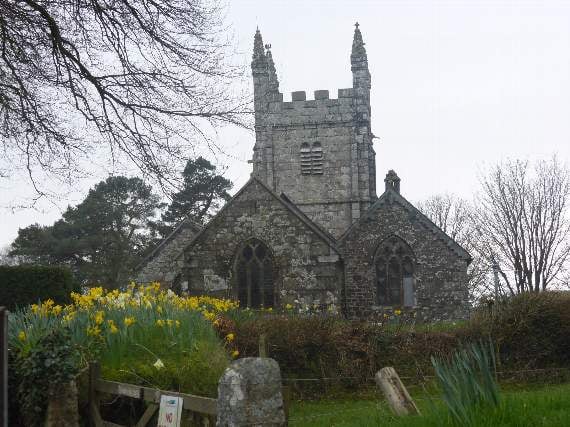Times reporter John Hutchins accompanies Dartmoor National Park Authority’s archaeologist Andy Crabb and communications officer Mike Nendick for a pleasant and informative walk around the historic sites of Lydford.
TO those who visit Lydford for the first time the place may well just come over as just another small, picturesque West Devon village albeit memorable for its distinctive gorge, former railway station, Norman ’castle’and St Petroc church set amid rural, stone cottages and a fine public house.
However, for those who wish to dig a little further they will find the little village by the River Lyd, has a deep vein of rich history worth tapping into and a fascinating tale of how Lydford has evolved over the centuries into the place it is today.
First records indicate it was followers of Petroc — Cornwall’s patron saint - who founded a Christian settlement in the sixth century.
By 900AD, at the time of the Saxons, it was a burgh (a fortified settlement) and would have had a wooden Christian church, dedicated to St Petroc. Lydford evolved into a powerful place, connected with the Royal Forest of Dartmoor and the Saxon kings of Wessex.
It was at the time of the ninth and 10th centuries that under the Saxons the village began to grow in significance and before the Norman Conquest in 1066 – Lydford was perhaps the most populous town in Devon apart from Exeter and known as a place of high status.
During the reign of King Aethelred the Unready (978-1016) the king established a mint there, where silver pennies were produced as the currency of his realm. Indeed such was Lydford’s prosperity that it soon attracted the attention of Viking raiders. In 997AD. The attack was successfully repelled, so the disgruntled Scandinavians took their frustration ‘down river’ to Tavistock where they ransacked the abbey instead.
It is believed around a million coins were minted there by 1050, of which only 400 remain today - the majority of which can be found in Swedish museums owing to the fact that the Vikings ’extracted’ the money from the Saxons as ’Danegeld’ (a tribute or ’protection’ tax).
Dartmoor National Park archeologist Andy Crabb explained: ‘As an archaeologist, to me Lydford is such a gem with a real depth of history and an intrinsic part of Dartmoor with its connections to the Saxon and Norman periods, its role as a major town of the then Royal Forest and later its importance to the local tin industry.
‘The remains we see today were in the time of King Alfred of Wessex (900AD) a burgh, or a fortified settlement where the residents of the town and their livestock could gather when the Danes came attacking. You can just make out the ramparts and parts of a walkway all around it. This site has such a good defensive landscape.
‘Lydford, or Hlidan in Saxon language, was an important place in Saxon times as a market town, but over the centuries turned into a shrunken settlement and as a burgh did not take off as places such as Totnes or Barnstaple and as a market lost its significance as places like Okehampton, Tavistock and South Zeal grew.’
In the 11th and 12th century Devon was a rebellious place, where the Norman overlords struggled to quell the rebellious Saxons and so they decided to build a ringwork at Lydford.
As Andy explained: ‘The first castle in Lydford, sometimes termed the Norman fort, was a small ringwork built in a corner of the Anglo-Saxon fortified burgh in the years after the Norman conquest of England. It was intended to help control Devon following the widespread revolt against Norman rule in 1068. The Norman fort was abandoned by the middle of the 12th century.
‘The second castle in Lydford was constructed in 1195 following a wave of law and order problems across England. It included a stone tower with a surrounding bailey, and rapidly became used as a prison and court to administer the laws in the Forest of Dartmoor and the Devon stannaries. The tower was rebuilt in the middle of the 13th century, probably in the 1260s by Richard, the Earl of Cornwall. It was redesigned to resemble a motte and bailey castle, an antiquated design for the period but one that was heavily symbolic of authority and power. In 1342 the castle, still being used as a prison and courtroom, passed to the Duchy of Cornwall, who owned it until the 20th century.
‘The condition of the castle varied considerably over time, and was repeatedly renovated and then left to deteriorate once again. Nonetheless, other than a period during the English Civil War and the Restoration in the 17th century, Lydford Castle played an important part in stannary and forest administration until the 19th century. ‘The castle acquired a bad reputation for injustice in the 14th century, and complaints about ’Lydford Law’ persisted for centuries. In the early 19th century, however, Dartmoor Prison was constructed, and Lydford ceased to be the centre for legal administration. The castle fell into ruin by the middle of the century.
‘In 1932, Lydford Castle passed into the hands of the state, and in the 21st century is run by English Heritage as a tourist attraction. Historian Andrew Saunders has described the castle as architecturally significant, being “the earliest example of a purpose-built gaol’ in England.’
The earthworks of the Norman fort are now owned by the National Trust and are open to the public. Indeed for those interested in the town’s history or just enjoying a healthy stroll around the sites and footpaths, Lydford is an integral part of Dartmoor’s rich heritage with many mysteries from its past yet to be uncovered.’
Mike Nendick concluded by telling the Times: ‘Often when I show people around Dartmoor they take in and think about the wonderful, open moor lands but they don’t see it as a place of settlement, where people live and work. That’s what is so appealing about Lydford – there is so much history here, it’s such a fascinating place and so well preserved – its well worth a visit.’
Rough Justice dished out at the castle with ’Lydford Law’
‘Lydford Law’ not only became a Dartmoor tradition, its fame spread nationwide and became synonymous for meaning ‘unfair justice’.
‘Hang first and try afterwards was the maxim’.
Probably one of the best descriptions of what Lydford Law was comes in prosaic form in 1644 from the Tavistock poet — William Browne:
‘I oft have heard of Lydford Law,
How in the morn they hang and draw.’
It is to the tinners and their stannary courts that responsibility for this harsh justice lies.
As Browne notes in his poem if anyone was unfortunate enough to be thrown in Lydford Gaol then they could expect to be hung before they had been judged. This was deemed preferable to languishing in the foul, cramped prison where even drinking water came from rainwater which ran off the roof.
By the 12th century the Norman kings soon identified the need to control the tin industry and the old customary laws were embodied in a new set of regulations called the Assize of Mines. In addition the entire county of Devon was classed as a royal forest and was subject to laws, which acted to preserve game. Various officials and courts enforced these laws together with the mining codes, some of which could involve imprisonment.
If a miner was brought before the Stannary Court and found guilty of adulterating tin for fraudulent purposes he would have three spoonfuls of molten tin poured down his throat as punishment.
Conditions were just as horrendous in the the times of Richard Strode. In 1510, Strode, a Member of Parliament, was infamously arrested by Stannary officials and imprisoned in Lydford Castle.
With the aid of some fellow MPs, Strode attempted to introduce legislation restricting the rights of tin miners on Dartmoor. However, Strode was himself a tinner, and an influential competitor brought charges against Strode in the Stannary Court, a regional tribunal empowered to judge mining disputes. Strode was fined £160, but refused to pay the fine, whereupon he was imprisoned at Lydford Castle.
He was released three weeks later by a letter from the Exchequer; at Strode’s request, Parliament had passed a law (Strode’s Act) reversing the local court decision and granting him immunity from further prosecution related to his Parliamentary activities.
• With thanks to Dartmoor National Park, English Heritage and Fred Hammett.





Comments
This article has no comments yet. Be the first to leave a comment.